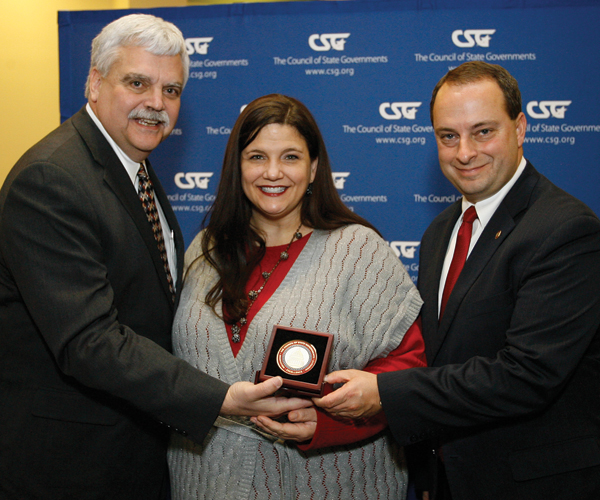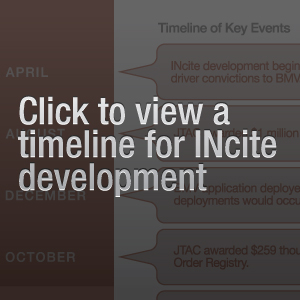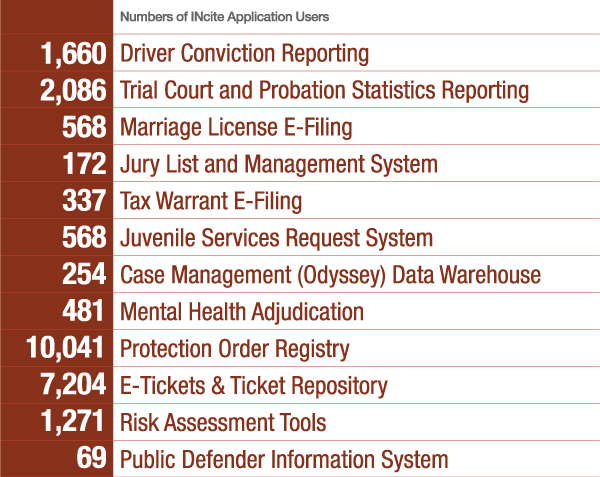A look at the award-winning INcite framework for court data sharing
 In 2005, the Indiana Supreme Court’s Judicial Technology and Automation Committee (JTAC) initiated a project that would enable courts to submit electronically commercial driver violations to the Bureau of Motor Vehicles (BMV). Like other states, Indiana was at risk of losing millions in federal funding for highways unless our courts could reduce the time between conviction and reporting to the BMV. We called the project INcite—the Indiana Courts Information Technology Extranet.
In 2005, the Indiana Supreme Court’s Judicial Technology and Automation Committee (JTAC) initiated a project that would enable courts to submit electronically commercial driver violations to the Bureau of Motor Vehicles (BMV). Like other states, Indiana was at risk of losing millions in federal funding for highways unless our courts could reduce the time between conviction and reporting to the BMV. We called the project INcite—the Indiana Courts Information Technology Extranet.
Though INcite’s original purpose was focused on commercial drivers, it very quickly became clear that courts and related offices had significant need for similar systems to handle transfer of local data to the state and federal levels—or vice versa—in many areas of their work. Indeed by 2007, INcite included an additional four applications, and today the site houses eleven applications for use by trial courts, clerks, probation officers, law enforcement, and victim advocates.
Late last year, the Council of State Governments (CSG) presented Indiana with an Innovations Award for INcite. CSG has been selecting Innovations Award winners since 1986 in an effort to promote successful state projects that have the potential to be replicated or modeled by other states.

What exactly is INcite?
After the initial success of the first application for commercial driver convictions, JTAC identified similar potential web applications to serve courts and clerks. Often, these project ideas were the result of requests for help from local courts or requirements in newly effective legislation. As the need for those additional applications became apparent, so did the need for a standardized method for building, securing, and managing them. A more refined approach to development was need for these new applications. That led to the creation of the INcite Framework.
 Users of INcite know it as a secure website that allows them to exchange data, whether reporting statistics or convictions, tracking a probationer’s progress, or downloading a jury list. Developers of INcite know it as a framework—both a blueprint that dictates the technical specifications of any application or interface developed for the site, and a foundation for new applications, which includes user account management, security, and shared data.
Users of INcite know it as a secure website that allows them to exchange data, whether reporting statistics or convictions, tracking a probationer’s progress, or downloading a jury list. Developers of INcite know it as a framework—both a blueprint that dictates the technical specifications of any application or interface developed for the site, and a foundation for new applications, which includes user account management, security, and shared data.
In the beginning of INcite, applications sprang up like houses in a city neighborhood—different architectural styles, different builders, and no rules about how high the fence can be. The INcite Framework is more like a planned, gated community with rules about things like paint color, building materials, and mailbox height. Rules like these may take a bit of the charm out of a neighborhood, but they create only benefits when it comes to developing a website.
Single Sign-on and Password Recovery. One of the basic components of the framework is the ability to create an account for an individual user and then assign that user access to applications that correspond with the user’s job function. The user then logs in to INcite once and can access all of her available applications. If she forgets her password, instead of calling the helpdesk, she can use the automated system for password retrieval or reset the password.
Security. For INcite developers, the fact that security is built into the framework has a huge impact on development time and complexity. Without the framework, each application would have to include its own security model; because of the framework, developers needn’t worry about security and can focus on functionality.
Shared Data. Another time saver for developers is the availability of shared data in the framework. For example, if two different INcite applications both need to have a field for an attorney name, both applications can pull attorney names from the same source of data—in this case, the Roll of Attorneys. As attorney records are updated, the attorney information in those applications is updated, so not only does this feature simplify development, but it also increases the accuracy of data.
Event Logs. Tracking events—especially errors—on the INcite server helps developers and administrators keep the site up and running efficiently.

What has INcite helped Indiana accomplish?
The various applications now available to courts and clerks through INcite have saved state and local government offices both time and money, and in many cases, they’ve improved public safety or enhanced Hoosiers’ access to justice. Here are some examples:
$34 million in federal highway funds secured
With the development of the first INcite application—funded by a federal grant—Indiana met the federal requirements and brought the time period between commercial driver conviction and reporting to the BMV from an average of more than 53 days to less than 8 days. This accomplishment helped secure $34 million in annual highway funds.
Law Enforcement man-hours reduced
According to Lt. Col. John Clawson of the Indiana State Police, since they implemented the Electronic Citation and Warning System (eCWS), over 20 full-time data entry positions have been eliminated. Further, it is estimated that over 22 thousand man-hours to date have been saved because law enforcement personnel no longer have to complete data entry on protection orders thanks to the Protection Order Registry.
Clerks’ offices save money
Without INcite’s Tax Warrant application available free to Clerks around the state, local governments would collectively spend over $150,000 each year for annual maintenance on a replacement system. Many Clerks would still be processing tax warrants manually, but because INcite is available, they not only don’t have an annual fee, they’re receiving filing fees from the Department of Revenue in a more timely way.
Victims are better served and protected
Indiana’s Protection Order Registry (POR)—developed with federal grant money and made mandatory statewide by the Indiana General Assembly in 2009—has drastically improved the transfer of data from local to state to federal law enforcement. As a result, access to data about active protection orders empowers police to enforce the orders effectively. Today, a victim can apply for a protection order in the comfort and privacy of a victim advocate’s office instead of exposing her private life in a busy Clerk’s office. Soon, victims will receive email and text message alerts about the status of their protection orders, and the public will be able to search non-confidential protection order information online.